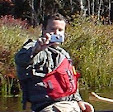I had hoped to do the Branch River today, but it didn’t work out, so I headed up to the fishing area in Harrisville to paddle the Nipmuc River. I’ve done this trip several times before, so I knew there would be beaver dams and downed trees. The river was at
3.7 feet, 30 cfs. - not a bad level.
As I approached the first beaver dam I could see it was in great shape. It had a fresh layer of sticks and mud, and was holding back 2 to 3 feet of water. The beaver lodge just up stream also had a fresh layer of sticks and mud, and had a large collection of sticks nearby – perfect for a winter snack. The beavers had been busy.
I paddled upstream, thought the fields and into the marshy woods. This is where we usually end up turning back due to fallen trees, but I decided to keep going upstream. I paddled around a couple fallen trees, and had to get out and carry over a few more.
I continued upstream to the
USGS gage where the river enters a beautiful hemlock forest. The river was shallow, and eventually, I had to get out and walk. I walked upstream another mile, wading around boulders and up several small rocky drops. It was beautiful, but unfortunately, I forgot my camera back at the car.
I’d definitely like to do a run down this section of the river when there is more water. Paul says that the put in is off Brook Road in Burrillville and that it is good above 4.5 feet.
Links:
Nipmuc River Gage near Harrisville










